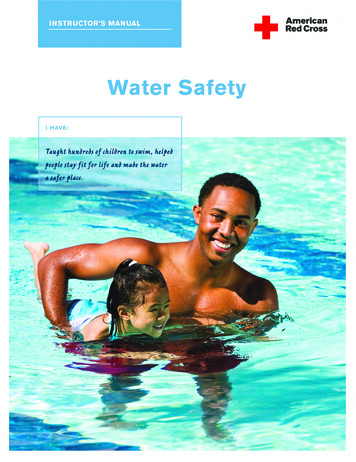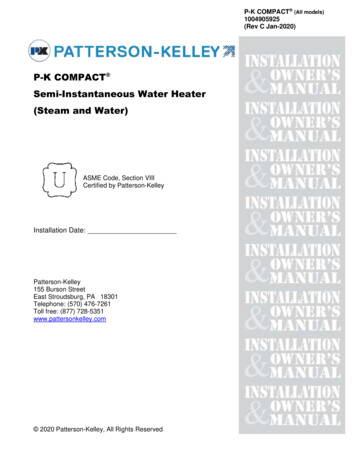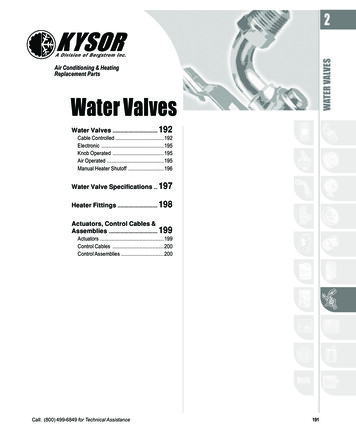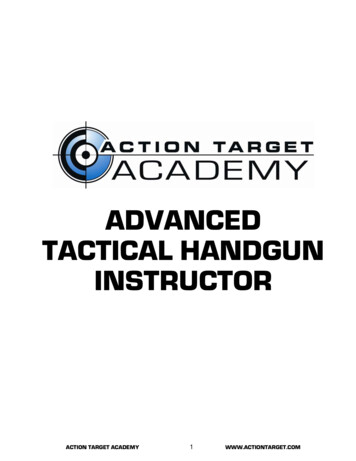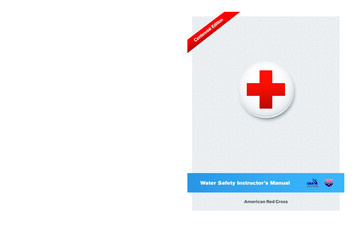
Transcription
noitdiElainentnCeWater Safety Instructor’s Manual
American Red CrossWater SafetyInstructor’s Manual
This instructor’s manual is part of the American Red Cross Swimming and Water Safetyprogram. Visit redcross.org to learn more about this program.The emergency care procedures outlined in this book reflect the standard of knowledge andaccepted emergency practices in the United States at the time this book was published. It isthe reader’s responsibility to stay informed of changes in emergency care procedures.PLEASE READ THE FOLLOWING TERMS AND CONDITIONS BEFORE AGREEINGTO ACCESS AND DOWNLOAD THE AMERICAN RED CROSS MATERIALS.BY DOWNLOADING THE MATERIALS, YOU HEREBY AGREE TO BE BOUNDBY THE TERMS AND CONDITIONS.The downloadable electronic materials, including all content, graphics, images and logos, arecopyrighted by and the exclusive property of The American National Red Cross (“Red Cross”).Unless otherwise indicated in writing by the Red Cross, the Red Cross grants you (“recipient”)the limited right to download, print, photocopy and use the electronic materials, subject to thefollowing restrictions: The recipient is prohibited from reproducing the materials for any reason. The recipient is prohibited from creating electronic versions of the materials. The recipient is prohibited from revising, altering, adapting or modifying the materials. The recipient is prohibited from creating any derivative works incorporating, in part orin whole, the content of the materials. The recipient is prohibited from downloading the materials and putting them on theirown website without Red Cross permission.Any rights not expressly granted herein are reserved by the Red Cross. The Red Cross does notpermit its materials to be reproduced or published without advance written permission from theRed Cross. To request permission to reproduce or publish Red Cross materials, please submit yourwritten request to The American National Red Cross.Copyright 2014 American National Red Cross. ALL RIGHTS RESERVED.The Red Cross emblem, American Red Cross and the American Red Cross logo aretrademarks of The American National Red Cross and protected by various national statutes.Published by Krames Staywell Strategic Partnerships DivisionPrinted in the United States of AmericaISBN: 978-1-58480-606-6
AcknowledgmentsThis manual is dedicated to the thousands of employees and volunteers of the American Red Cross who contributetheir time and talent to supporting and teaching swimming and lifesaving skills worldwide and to the thousands ofcourse participants and other readers who have decided to be prepared to take action when an emergency strikes.Many individuals shared in the development and revision process in various supportive, technical and creativeways. The Swimming and Water Safety program was developed through the dedication of both employees andvolunteers. Their commitment to excellence made this manual possible.The following members of the American Red Cross Scientific Advisory Councilprovided guidance and review:Peter Wernicki, MDRoy FieldingTerri LeesAquatics Chair, American Red CrossScientific Advisory CouncilSports Medicine Orthopedic Surgeon,Vero Beach, FloridaAssistant Clinical Professor, Dept. ofOrthopedic Surgery, Florida St. UniversityCollege of MedicineChair, International Lifesaving FederationMedical CommitteeMedical Advisor, U.S. Lifesaving AssociationMember, American Red Cross ScientificAdvisory CouncilThe University of North Carolina atCharlotte, Department of KinesiologyCoordinator, Exercise Science/Directorof AquaticsCharlotte, North CarolinaMember, American Red Cross ScientificAdvisory CouncilAquatic SupervisorNorth Kansas City Community CenterNorth Kansas City, MissouriLinda Quan, MD, FAAPVice Chair, American Red Cross ScientificAdvisory CouncilUniversity of Washington School of MedicineSeattle Children’s HospitalSeattle, WashingtonPeter Chambers, PhD, DOMember, American Red Cross ScientificAdvisory CouncilFlight Surgeon, Medical CorpsPatrick Air Force Base, FloridaLouise KublickMember, American Red Cross ScientificAdvisory CouncilHolland Bloorview Kids RehabilitationHospitalOperations Manager, AquaticsToronto, Ontario, CanadaWilliam Dominic Ramos, PhDMember, American Red Cross ScientificAdvisory CouncilIndiana UniversitySchool of Public Health – BloomingtonDirector – IU Aquatics InstituteAssistant ProfessorBloomington, IndianaStephen J. Langendorfer, PhDMember, American Red Cross ScientificAdvisory CouncilProfessor, KinesiologyBowling Green State UniversityBowling Green, OhioGuidance provided by the American Red Cross:Jack McMasterDominick TolliJean ErdtmannPresidentPreparedness and Health and Safety ServicesVice PresidentPreparedness and Health and Safety ServicesExecutive DirectorPreparedness and Health and Safety ServicesAcknowledgmentsiii
The American Red Cross team for this edition included:Margot AllowayConnie HarveyJohn ThompsonBusiness AnalystInformation TechnologyDirector, Centennial InitiativePreparedness and Health and Safety ServicesManager, Business OperationsPreparedness and Health and Safety ServicesAnthony AltieriDenise HensalJoy ZukauskaseLearning Systems AdministrationInformation TechnologyBusiness AnalystInformation TechnologyCatherine BarryDon LauritzenProduct Manager, Training SupportCenterPreparedness and Health and Safety ServicesDirector, AquaticsPreparedness and Health and Safety ServicesOfficerCommunicationsSue DegnanAnnette PallowickSenior Marketing ManagerMarketingInstructor Trainer/ProgramDevelopment, AquaticsPreparedness and Health and Safety ServicesGina GunnProduct Manager, Training SupportCenterPreparedness and Health and Safety ServicesStephanie ShookSenior Product Manager, AquaticsPreparedness and Health and Safety ServicesThe StayWell team for this edition included:Nancy MonahanDanielle DiPalmaLaura ScottSenior Vice PresidentEditorial DirectorContent ManagerSunil BhedaMelanie CannMaureen PanczaSenior Vice PresidentProduct DevelopmentExecutive EditorEditorial Project ManagerPaula BattMichael DelPolitoMichelle ClarkExecutive EditorSenior Graphic DesignerMaryann FoleyMolly EvansSenior Content ManagerMarketing ManagerVice PresidentSales and Client ServicesDavid CaneManaging EditorSpecial ThanksSpecial thanks to the following individuals for their expertise asSubject Matter Experts:Matt BarbiniTara Eggleston, M.S.Karen JosephsonUSA Swimming National Team,High Performance ConsultantColorado Springs, ColoradoAssistant Division Chief/CountywideAquatics CoordinatorMaryland-National Capital Park andPlanning CommissionIllustrator and Synchro SwimmingExpert, esynchro.comConcord, CaliforniaU.S. Olympian, 1988 Olympic SilverMedal, 1992 Olympic Gold Medal,Duet Synchronized SwimmingJason BaumannUSA Diving, Director of EducationIndianapolis, IndianaScott ColbyMyriam GlezHigh Performance Director,USA Synchronized SwimmingIndianapolis, IndianaUSA Swimming, Sport PerformanceConsultantColorado Springs, Coloradoiv Water Safety Instructor’s ManualRussell MarkUSA Swimming National Team,High Performance ConsultantColorado Springs, Colorado
ContentsPart A:AdministrationChapter 1: General Program AdministrationSwimming and Water Safety Program 3Instructor Responsibilities 6Instructor and Instructor Trainer Resources 8Facility Considerations 11Staffing 11Class Safety 13Records and Reports 15Course Evaluation 15PART B:Teaching Swimming and Water SafetyChapter 2: Promoting Effective LearningDevelopmental Principles of Learning Motor Skills 19Stages of Learning Motor Skills 22Helping Participants Learn 24Teaching Strategies 32Chapter 3: Planning and Conducting Effective and Safe Swim LessonsPlanning a Course Session 40Organizing the Class 47Holding and Support Techniques 52Flotation Devices 58Chapter 4: Integrating Water Safety into the CoursesPutting Water Safety into Practice 65Water Safety as Part of Learning to Swim 65Key Water Safety Topics 68Contents v
Basic Water Safety Rules 71Recognizing the Lifeguards 72Staying Safe Around Water 72Circle of Drowning Prevention 74General Water Safety Around the Home 74Safety at the Beach and at the Waterpark 75The Importance of Wearing a Life Jacket 76The Danger of Drains 77Recreational Water Illnesses 78Sun Safety 78Water Toys and Their Limitations 79Developing Breath Control Safely 80Chain of Drowning Survival 81Recognizing an Emergency 82How to Call for Help 82How to Call for Help and the Importance of KnowingFirst Aid and CPR 83Reaching Assists 84Swim as a Pair Near a Lifeguard’s Chair 86Look Before You Leap 87Think So You Don’t Sink 88Don’t Just Pack It, Wear Your Jacket 90Think Twice Before Going Near Cold Water or Ice 91Know About Boating Before You Go Floating 92Chapter 5: Teaching People of Different AgesInfants and Young Children 95School-Age Children 100Adults 101Chapter 6: Teaching People Who Move, Learn, Communicateor Behave DifferentlyAquatics Programming Options 109Helping Participants to Succeed 110Teaching People with Sensory Impairments 117vi Water Safety Instructor’s Manual
Teaching People with Impaired Mobility 122Teaching People with Medical Conditions 124Teaching People with Developmental Disabilities 127Teaching People with Learning Disabilities 130Teaching People with Emotional or Behavioral Disabilities 132PART C:The CoursesChapter 7: Parent and Child AquaticsAdministrative Notes 135Safety Considerations 137Working with Young Children and Their Parents 138The Parent and Child Aquatics Course 143Parent and Child Aquatics Level 1 147Parent and Child Aquatics Level 1 Skills 150Parent and Child Aquatics Level 2 165Parent and Child Aquatics Level 2 Skills 168Chapter 8: Preschool AquaticsAdministrative Notes 183Safety Considerations 187Working with Preschoolers 188The Preschool Aquatics Course 192Preschool Aquatics Level 1 193Preschool Aquatics Level 1 Skills 196Preschool Aquatics Level 2 207Preschool Aquatics Level 2 Skills 210Preschool Aquatics Level 3 215Preschool Aquatics Level 3 Skills 218Chapter 9: Learn-to-SwimAdministrative Notes 224Safety Considerations 228Contents vii
Working with School-Age Children and Young Teens 229Learn-to-Swim Course 230Learn-to-Swim Level 1—Introduction to Water Skills 233Learn-to-Swim Level 1 Skills 236Learn-to-Swim Level 2—Fundamental Aquatic Skills 239Learn-to-Swim Level 2 Skills 242Learn-to-Swim Level 3—Stroke Development 247Learn-to-Swim Level 3 Skills 250Learn-to-Swim Level 4—Stroke Improvement 261Learn-to-Swim Level 4 Skills 264Learn-to-Swim Level 5—Stroke Refinement 279Learn-to-Swim Level 5 Skills 282Learn-to-Swim Level 6—Swimming and Skill Proficiency 291Learn-to-Swim Level 6—Personal Water Safety 293Learn-to-Swim Level 6—Personal Water Safety Skills 296Learn-to-Swim Level 6—Fundamentals of Diving 305Learn-to-Swim Level 6—Fundamentals of Diving Skills 309Learn-to-Swim Level 6—Fitness Swimmer 321Learn-to-Swim Level 6—Fitness Swimmer Skills 324Chapter 10: Adult SwimAdministrative Notes 331Safety Considerations 333Working with Older Teens and Adults 334Adult Swim Courses 337Adult Swim—Learning the Basics 339Adult Swim—Learning the Basics Skills 343Adult Swim—Improving Skills and Swimming Strokes 347Adult Swim—Swimming for Fitness 351Chapter 11: Water Safety Courses and PresentationsWater Safety Courses 355Water Safety Presentations 358viii Water Safety Instructor’s Manual
PART D:Course CompletionChapter 12: Recognizing and Rewarding AchievementLearn-to-Swim Courses 363Water Safety Courses 366SOURCES 369INDEX 374Contents ix
Part AAdministration
cHaPter 1GENERAL PROGRAMADMINISTRATIONThe purpose of the American Red Cross Swimming and Water Safety program is two-fold:to teach people how to be safe in, on and around water; and to teach people of all ages andvarying abilities how to swim. Using a logical progression, the program covers the knowledgeand skills needed for aquatic skill development, which, in turn, leads to safer and better swimmers.2 Water Safety Instructor’s Manual
Swimming and Water Safety ProgramThe Red Cross Swimming and Water Safety program teaches people of all ages and varying abilities toswim and be safe in, on and around water. Swimming readiness and swim instruction courses withinthe Red Cross Swimming and Water Safety program include Parent and Child Aquatics, PreschoolAquatics, Learn-to-Swim and Adult Swim courses. These courses take an inclusive approach thatemphasizes skill development in conjunction with water safety and drowning prevention education.The Red Cross Swimming and Water Safety program also includes a variety of water safety coursesand presentations to help teach all age groups how to enjoy the water safely and how to stay safe in theevent of an emergency.Program DesignWater safety and drowning prevention are important concepts to emphasize as part of any swimmingand water safety program. In the United States, drowning ranks second (behind motor vehicle crashes)as a cause of death from unintentional injury in children ages 1 through 14, with children between theages of 1 and 4 years having the highest rate for drowning. As a Water Safety instructor, you must givecareful attention to the safety of all participants. Remind parents that even if their children have learnedto move in the water, they still lack the judgment needed to recognize dangerous situations and thestrength, stamina and ability to swim to safety if necessary.In an effort to address water safety and drowning prevention, the American Academy of Pediatrics(AAP, 2010) has issued the following policy statement related to swim lessons:“Children need to learn to swim. The AAP continues to support swimming lessons for mostchildren 4 years old and older. Because children develop at different rates, not all children willbe ready to learn to swim at exactly the same age. The evidence no longer supports an advisoryagainst early aquatic experience and swimming lessons for children of any specific age. However,the current evidence is insufficient to support a recommendation that all 1- to 4-year-old childrenreceive swimming lessons. A parent’s decision about starting swimming lessons or water-survivalskills training at an early age must be individualized on the basis of the child’s frequency ofexposure to water, emotional maturity, physical limitations, and health concerns related toswimming pools. Parents should be reminded that swimming lessons will not provide ‘drownproofing’ for children of any age.”Highlights of the Red Cross Swimming and Water Safety program include: An emphasis on water safety and drowning prevention as the basis of swimming and waterrecreation. Distribution of skills throughout the swim instruction program to optimize skill acquisition so thatparticipants can achieve success at regular intervals. The most current biomechanics concepts and stroke descriptions. Content to help Water Safety instructors improve their teaching skills and better serveparticipants of varying ages and abilities, including those who may move, behave, learn orcommunicate differently.Chapter 1 General Program Administration 3
A mobile application to support the progress that participants make throughout the levels whilelearning to swim, to encourage continued participation in the program and to help educate parentsto be safe in, on and around the water. Extensive instructor support resources including the Water Safety Instructor’s Manual, Swimmingand Water Safety, Swimming and Water Safety Program DVD set and Instructor’s Corner(instructorscorner.org).courses and PresentationsThe Red Cross Swimming and Water Safety program is made up of the following coursesand presentations: Water Safety Instructor: The purpose of the Water Safety Instructor course is to train instructorcandidates to teach Parent and Child Aquatics, Preschool Aquatics, Learn-to-Swim, Adult Swimcourses, and water safety courses and presentations. Water Safety instructor candidates must be16 years old on or before the last scheduled day of the Water Safety Instructor course. Parent and Child Aquatics (2 levels): The purpose of Parent and Child Aquatics is to teach safebehaviors in, on and around the water and to develop swimming readiness. Parents and childrenengage in water exploration activities with the objective of having fun and becoming comfortable in,on and around the water. Preschool Aquatics (3 levels): Preschool Aquatics aims to promote the developmentallyappropriate learning of fundamental water safety and aquatic skills by young children.Red Cross Preschool Aquatics teaches aquatic and safety skills in a logical progression throughthree levels of courses. Learn-to-Swim (6 levels): Learn-to-Swim consists of six comprehensive levels that teach peopleof varying ages and abilities how to swim skillfully and safely. Each level includes training in basicwater safety in addition to aquatic and safety skills taught in a logical progression. The objective is toteach people to swim and to be safe in, on and around the water. The six levels include:Level 1—Introduction to Water Skills{ Level 2—Fundamental Aquatic Skills{ Level 3—Stroke Development{ Level 4—Stroke Improvement{ Level 5—Stroke Refinement{ Level 6—Swimming and Skill Proficiency Personal Water Safety Fundamentals of Diving Fitness SwimmerAdult Swim: The Adult Swim courses are intended for teens and adults with differing levelsof swimming ability. The following courses are available: 4{ { Adult Swim—Learning the Basics{ Adult Swim—Improving Skills and Swimming Strokes{ Adult Swim—Swimming for Fitness Water Safety Instructor’s Manual
Longfellow’s WHALE Tales: This dryland water safety program is intended for children ages5 through 12 and includes information on the following topics:{{Swim as a Pair Near a Lifeguard’s Chair{{Be Cool, Follow the Rules{{Look Before You Leap{{Think So You Don’t Sink{{Reach or Throw, Don’t Go{{Don’t Just Pack It, Wear Your Jacket{{Think Twice Before Going Near Cold Water or Ice{{Know About Boating Before You Go Floating{{Too Much Sun Is No Fun{{In Your House and in Your Yard, Watch for Water, Be on Guard{{Wave, Tide or Ride, Follow the GuideWater safety presentations: Water safety presentations help people learn to be safe in, on andaround the water. Certificates are not issued for these presentations. Topics include:{{General Water Safety{{Home Pool Safety{{Parent Orientation to Swim Lessons{{Sun Safety{{Rip Current SafetyWater safety courses: Water Safety instructors are eligible to teach the following water safetycourses for which participants receive a certificate of completion:{{Water Safety Today{{Basic Water Rescue{{Personal Water Safety{{Safety Training for Swim CoachesOnline only and digital options: Water Safety instructors are also encouraged to inform othersabout online courses and mobile applications, including:{{Home Pool Essentials: Maintenance and Safety online course{{Red Cross Swim mobile application Supports and promotes the Red Cross Swimming and Water Safety programAllows parents to track and share the progress of their children through the PreschoolAquatics and Learn-to-Swim levels.Provides adults with information about water safety in general, as well as water safety inspecific environments.Helps children learn about water safety through video segments from Longfellow’s WHALETales, age-appropriate water safety messaging, and quizzes for the parent and child tocomplete together.Chapter 1 General Program Administration 5
{ Red Cross first aid and preparedness mobile applications Tornado app Hurricane app Wildfire app Earthquake app First aid app Shelter finder appBefore teaching any of the courses or presentations that comprise the Red Cross Swimming and WaterSafety program, you should be familiar with Swimming and Water Safety, this instructor’s manual, andthese additional materials and resources: Outlines and leader’s guides provided on Instructor’s Corner (instructorscorner.org) for instructorsintending to teach water safety courses and presentations. The Longfellow’s WHALE Tales K–6 Educational Packet and Longfellow’s WHALE Tales DVD forinstructors who wish to teach Longfellow’s WHALE Tales. Red Cross Safety Training for Swim Coaches Blended Learning course, Safety Training for SwimCoaches Supplement and American Red Cross Safety Training for Swim Coaches Blended LearningInstructor’s Manual for instructors intending to teach the Safety Training for Swim Coaches course.Program ParticipantsThe Red Cross has developed age guidelines for the Swimming and Water Safety courses. Therecommended ages are only general guidelines. For children, take into consideration readiness,experience and maturity level when determining the course level in which participants should enroll.The general age guidelines are as follows: Parent and Child Aquatics: infants and toddlers from 6 months to approximately 3 years of age Preschool Aquatics: children approximately 4 to 5 years of age Learn-to-Swim: children from approximately 6 years of age through older youth Adult Swim: youth approximately 15 years old through adultsFor most water safety courses and presentations, there are no age prerequisites for participation.However, courses and presentations should have participants of similar ages and abilities so you cancustomize the lessons and conduct appropriate activities, addressing the appropriate knowledge, skillsand readiness for each level. Also, keep in mind that some courses and presentations are more suited toolder audiences. For more information on these topics, see Part C of this instructor’s manual.inStrUctor reSPonSiBilitieSAs a Water Safety instructor teaching courses in the Red Cross Swimming and Water Safety program,you must be associated with a facility that is enrolled as an Authorized Provider (AP) or LicensedTraining Provider (LTP) of the Learn-to-Swim program. An AP or LTP is an organization that hassigned a written agreement with the Red Cross to teach our training programs. Annual facilityenrollment is required.6 Water Safety Instructor’s Manual
As a Red Cross Water Safety instructor, you are responsible for: Providing for the health and safety of participants by always ensuring that:{{{{All equipment is clean and in good working order.All participants have the physical ability to perform the skills and know to consult you forconcerns about their physical ability to do so.{{All participants are aware of health precautions and guidelines concerning infectious diseases.{{The classroom, aquatic facility and all practice areas have been checked for any hazards. Foreseeing hazards and taking steps to control them before participants arrive or step into the water. Ensuring that there are lifeguards on duty with the proper safety equipment during swim lessons. Ensuring proper water quality in the swimming area. Being familiar with and knowing how to use course materials and training equipment safelyand effectively. Planning, coordinating and managing training with the Red Cross, including advising the Red Crossin advance of any classes you are scheduled to teach. Informing participants about knowledge and skill evaluation procedures and coursecompletion requirements. Creating a nonthreatening environment conducive to achieving the learning objectives. Preparing participants to meet the course objectives. Adapting your teaching approach to match the experience and abilities of the participants,identifying participants who are having difficulty and developing effective strategies to help themmeet course objectives. Supervising participants while they are practicing course skills and providing timely, positive andcorrective feedback as they learn. Evaluating participants as they perform skills, focusing on critical performance steps as describedin the course outlines, stroke performance charts and/or skill sheets. Conducting courses in a manner consistent with course design. Administering and scoring any final written exam(s), if applicable. Issuing course completion certificates. Submitting the required course documents according to current Red Cross procedural guidelineswithin the specified time frame. Being familiar with and informing participants of other Red Cross courses and programs. Being prepared to answer participants’ questions or knowing where to find the answers. Providing a positive example by being neat in appearance and not practicing unhealthy behaviors,such as smoking, while conducting Red Cross courses. Identifying potential instructor and instructor aid candidates and referring them to the appropriateRed Cross representatives. Abiding by the obligations in the Instructor Agreement and Code of Conduct and the AuthorizedProvider Agreement or Licensed Training Provider Agreement. Representing the Red Cross in a positive manner. Promoting volunteer opportunities available through the Red Cross.Chapter 1 General Program Administration 7
In addition, Red Cross instructors are expected to regularly access the Learning ion/login) and to maintain a current instructor profile there,including a current email address. The Red Cross uses the contact information in the instructor profileto communicate important information to instructors (for example, related to maintaining instructorcertification, reporting teaching activity or providing certificates to successful course participants).inStrUctor and inStrUctortrainer reSoUrceSExtensive resources are available to support Water Safety instructors and Water Safety instructor trainers.resources for water Safety instructorsWater Safety Instructor’s ManualThis instructor’s manual is a resource for those certified by the Red Cross as Water Safety instructors toteach Red Cross Swimming and Water Safety courses and presentations. It is available as a free download onInstructor’s Corner (instructorscorner.org) and can be purchased on Instructor’s Corner or shopstaywell.com.This instructor’s manual is the primary resource for Water Safety instructors, explaining and describingthe Red Cross Swimming and Water Safety program. The manual also provides directions for obtainingcourse materials from the appropriate resource on Instructor’s Corner (instructorscorner.org). Thismanual suggests teaching concepts, strategies, best practice steps and progressions, and provides tipsfor promoting participants’ success. In addition, it provides detailed inform
The StayWell team for this edition included: Nancy Monahan Senior Vice President Sunil Bheda Senior Vice President Product Development Paula Batt . The Red Cross Swimming and Water Safety program teaches people of all ages and varying abilities to swim and be safe in, on and around wate
